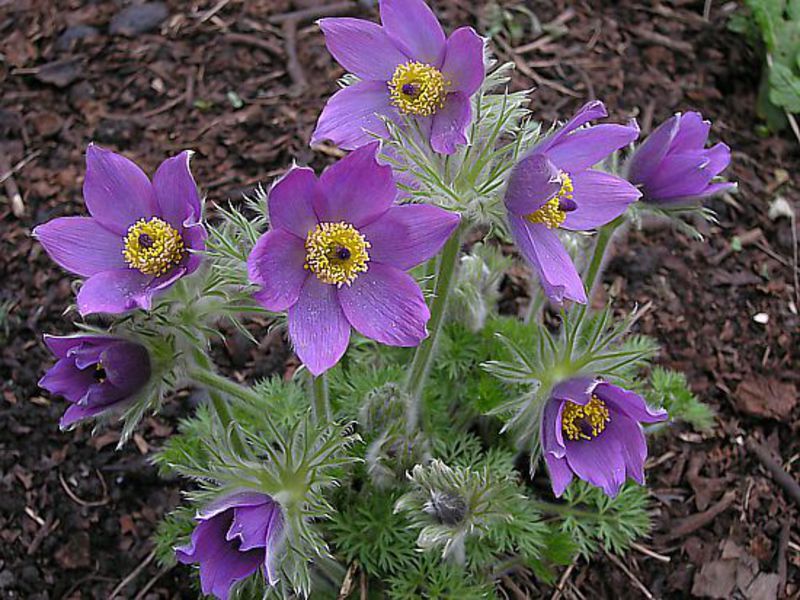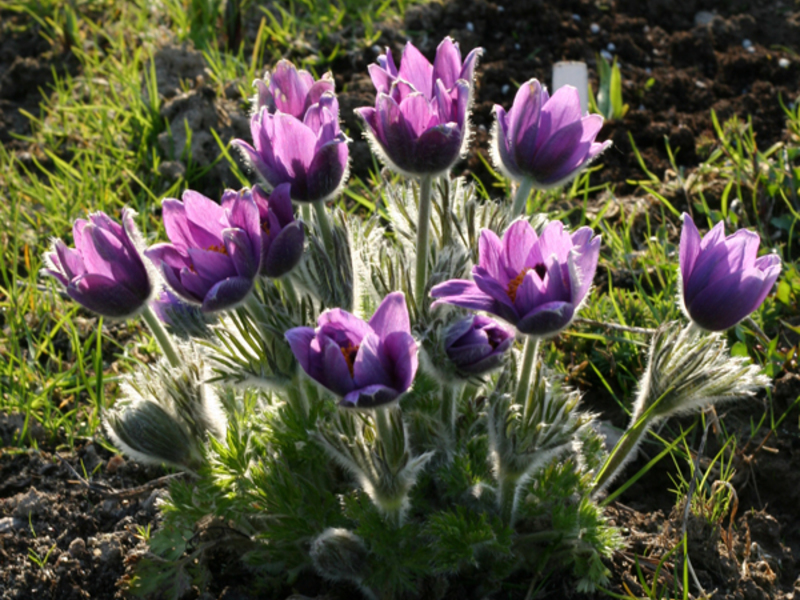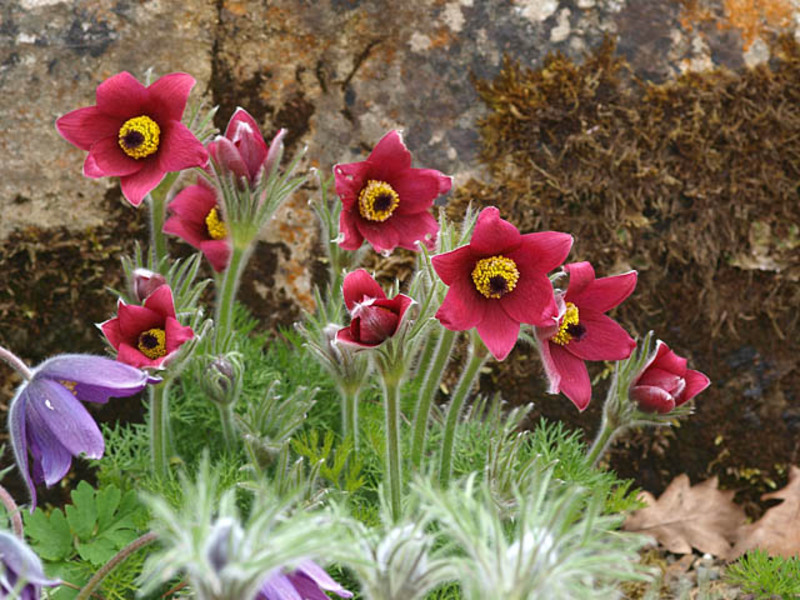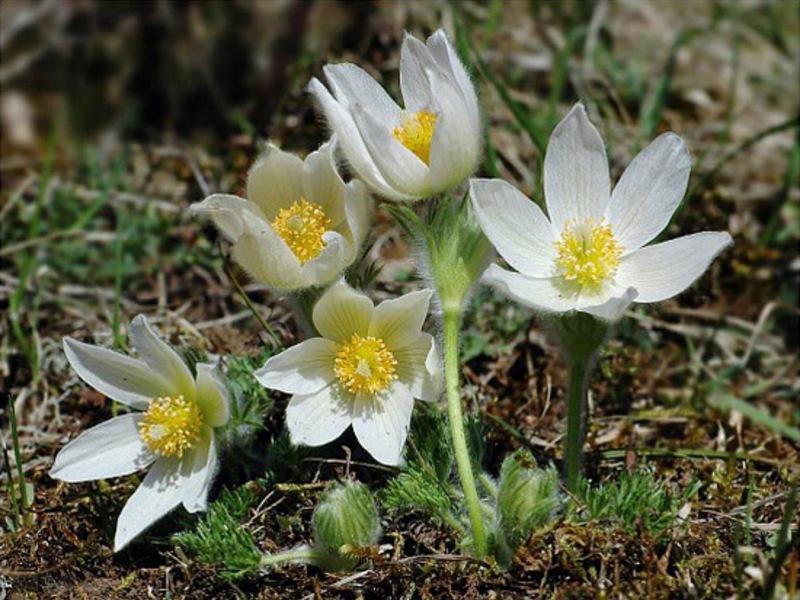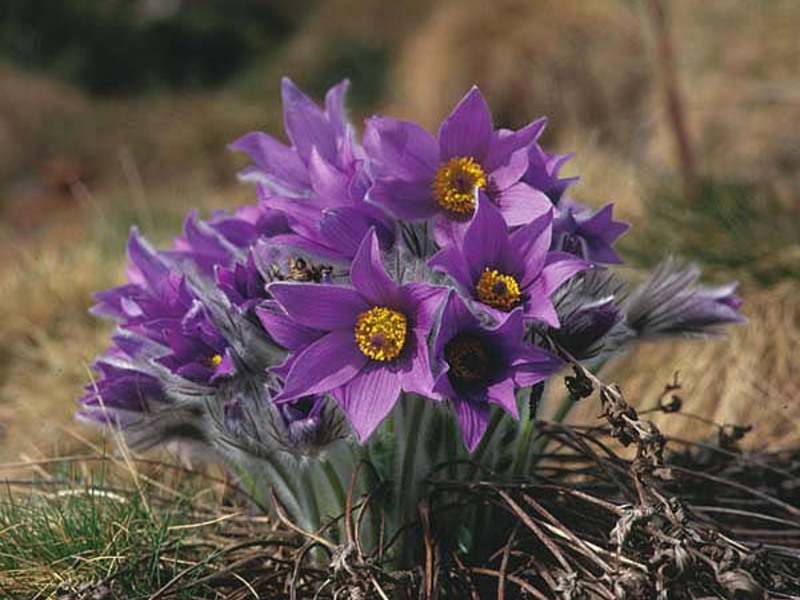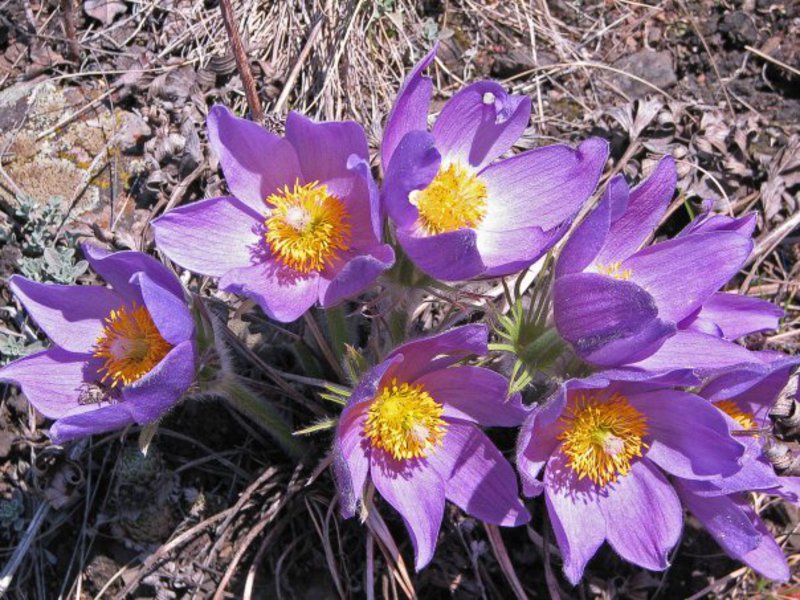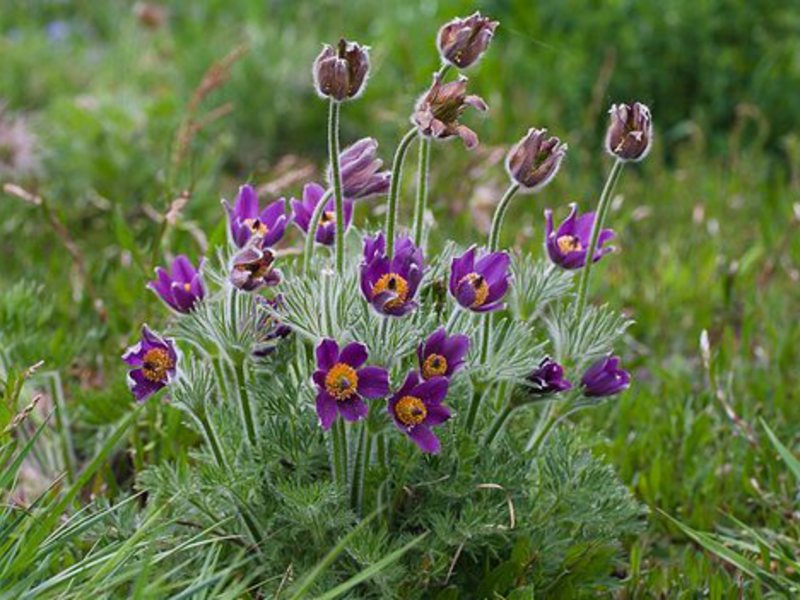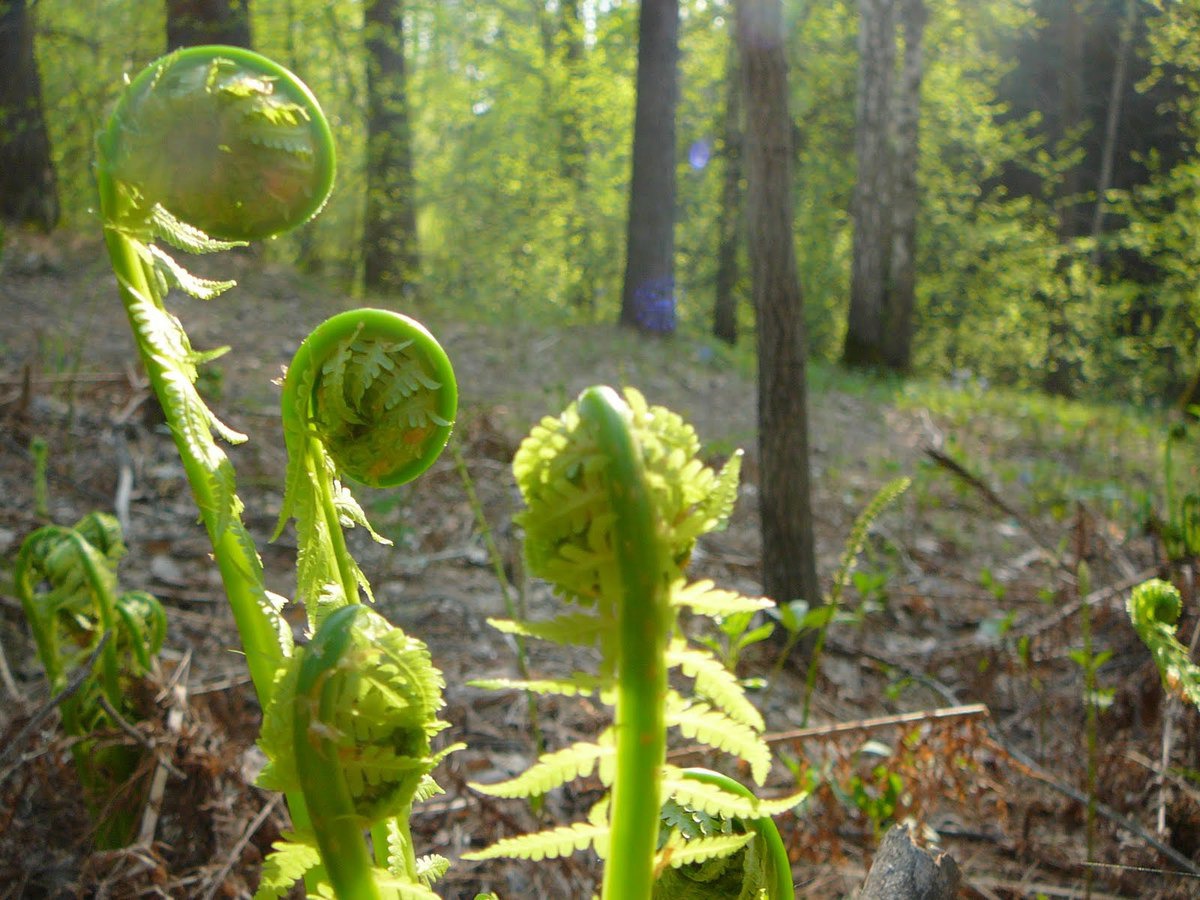Lumbago, or as they are popularly called, sleep-grass, from the buttercup family, grow in Siberia, Europe, and the Caucasus. There are 45 species in the genus. They grow straight and are covered with villi. Over time, when the flower grows older, it increases the number of leaves, and in adulthood there are already about 200 of them. The plant is about 50 cm long. The flowers are large, shaped like bells, about 8 cm in diameter. The color is white with golden or silver tint, golden yellow, violet, purple. As soon as the flower begins to fade, its peduncle lengthens, forming a multi-root fruit.
Content
Flowers lumbago: classification
These plants are very beautiful in order to preserve the species they are all in the "Red Book"... The main types are:
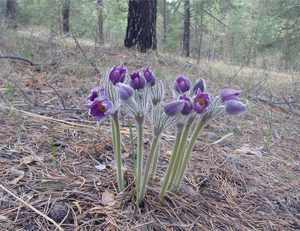 Common lumbago.
Common lumbago.- Spring.
- Disclosed,
- Yellowing,
- Lugovoi,
- Doubtful,
- Chinese.
Common lumbago, the photo of which is below, grows up to 30 cm. The flowers are covered with silvery-white pubescence. A rosette is formed from leaves of bright green color, which reach 20 cm. The leaves of the common lumbago, pubescent with a silvery-white color, appear at the time of flowering. Young foliage also has villi, which almost all disappear after flowering. Blooms from April to Mayreminds his kind of bell... By the buds of a future flower, you can determine its color, it is white, pale purple, pale purple. In diameter, the flowers reach 9 cm. Common lumbago has several forms: with snow-white flowers, with red, with red-violet, with black-red.
Common varieties are Mrs. Van der Elst ", which forms large pink flowers. Rodde Klokke has deep red, white flowers at White Swen. Common lumbago is able to withstand frost up to 20 degrees. For the plant to grow well, it should be planted in a well-drained calcareous soil. This species is common in Europe and Siberia.
Spring lumbago, the photo of which you see below, forms a bush, reaching 15 cm at the time of flowering, then grows up to 30-40 cm... The plant is densely pubescent with bronze-golden hairs. The leaves are able to withstand cold, since they are leathery, their color is bright green, reach a length of about 10 cm, collected in a rosette. During the flowering period, the leaves are already developed. Blooms for about 25 days in April or May with white bell-like flowers up to 6 cm in diameter. The attentive will notice their shade, which is light purple on the inside and pink on the outside. At the beginning of flowering, the flower head looks down, then straightens.
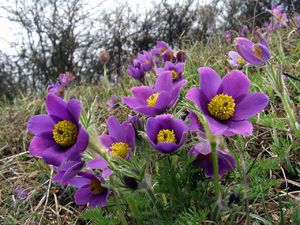 In natural conditions, it grows on dry slopes. Despite the fact that spring lumbago is widespread in nature, it is rather difficult to cultivate it. The plant does not tolerate alkali; preference is given to peat, humus, sand or soil, which has a complex set in its composition, including even coniferous needles. It follows from this that spring lumbago is short-lived, but it is easily bred by means of seeds. Plant planted in an open and sunny place.
In natural conditions, it grows on dry slopes. Despite the fact that spring lumbago is widespread in nature, it is rather difficult to cultivate it. The plant does not tolerate alkali; preference is given to peat, humus, sand or soil, which has a complex set in its composition, including even coniferous needles. It follows from this that spring lumbago is short-lived, but it is easily bred by means of seeds. Plant planted in an open and sunny place.
The open lumbago forms a shrub about 20 cm, about 10 cm in diameter.The plant has a powerful dark brown rhizome, the vertical stems are densely covered with protruding hairs, they are soft to the touch. The leaves of the open lumbago have a rounded verdseform, they are green in color, reaching 12 cm in length, pubescent.
The flowers outside are covered with protruding hairs, about 6 cm in diameter, at first they resemble a tulip, then turn into a six-pointed star, do not droop like bells. The color is lilac, blue-violet, sometimes yellowish or white-yellow. It blooms in April-May, then leaves appear, forming a rosette. Prefers open areas and limestone soils. Many-nut fruits ripen by May-June. In Russia, it can be found in the European part and Western Siberia. They grow up to the Irtysh in the east.
Yellowing grows, reaching a height and width of 20 cm. It is closely related to an open lumbago. Leaves on top have a darker green colorthan the top. In April-May, cup-shaped, large yellow with a gray tinge flowers are formed, reaching a diameter of 8 cm. The opened buds gradually turn yellow on the inside, and on the outside - bluish. If you choose the right place for growing, then the plant is winter-hardy and durable. Loves neutral or acidified soil. In the wild, it is distributed in the Urals (in the mountains). Grows from the Volga River to the Lena River.
Meadow lumbago reaches a height of 30 cm. It blooms for about a month from April to May, forming silvery-purple flowers drooping with a greenish tint. Distributed in the European part of our country. Found in pine forests, open sandy hills, sunny slopes.
Doubtful lumbago prefers to grow in limestone soils, it is common in Mongolia and Siberia. The peduncle reaches a length of 45 cm, flowers are formed from April to May. Near flowers, which can be blue, blue-violet, the leaves are bent back. The flowers resemble a bell. In Mongolia, lumbago is used as early spring feed for animals that quickly recuperate with it.
Chinese. This flower reaches 15 cm in height. When the fruit is formed, it grows to 30 cm. During the flowering period, forms drooping lilac-purple buds. The plant does not adapt well to spring and winter thaws.
Compositions in the garden
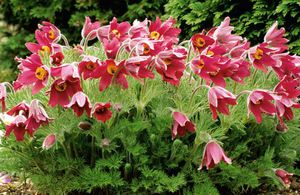 Flowering in lumbago earlier, it looks good with various shrubs and trees, it looks elegant in the garden. It is also combined with spring flowers, for example, with spring adonis, crocuses, primroses. They are planted along the paths. You can just take several varieties of this plant or try to grow a whole group. Don't dig up plants and transfer them from their natural habitat, since they will not survive the transplant anyway.
Flowering in lumbago earlier, it looks good with various shrubs and trees, it looks elegant in the garden. It is also combined with spring flowers, for example, with spring adonis, crocuses, primroses. They are planted along the paths. You can just take several varieties of this plant or try to grow a whole group. Don't dig up plants and transfer them from their natural habitat, since they will not survive the transplant anyway.
Planting and growing a plant
The lumbago is planted in a flower bed, where perennials coexist; an alpine slide and rockery are also suitable. The plant does not tolerate dampness! You need to choose a place for lumbago with a slight shade, but in sunny places, the culture also feels good. Place the flower on the south side of the garden. It is great if the chosen place is with a slope that will not allow water to stagnate. Since the seeds are light sensitive, it is best to cover them with a layer of soil, but not too much. Plant care:
- The lumbago needs to be fed. Fertilizers containing lime and nitrogen are suitable for this. Potassium-phosphorus fertilizing is also necessary, but they are applied only twice per season. There are chances and in poor soil, lumbago is able to grow from seeds without fertilization.
- The soil for sowing lumbago seeds should be treated with fertilizers that are applied in the fall. In the spring, before planting seeds, it is necessary to loosen the soil.
- Care should include weeding, watering as needed, mulching with peat and humus.This plant is frost-resistant, so it should endure the winter period without losses.
Reproduction
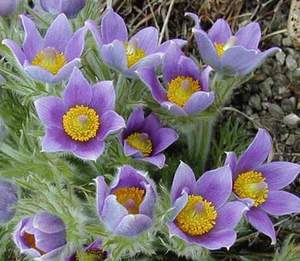 The plant is difficult to transplant, so it propagated by seeds... The flowering of a postrel planted in this way begins already in the second year of life. Keep in mind, however, that high-altitude varieties can delay flowering times by years. Therefore, buy ordinary lumbago seeds and there will be no problems with flowering.
The plant is difficult to transplant, so it propagated by seeds... The flowering of a postrel planted in this way begins already in the second year of life. Keep in mind, however, that high-altitude varieties can delay flowering times by years. Therefore, buy ordinary lumbago seeds and there will be no problems with flowering.
Fresh seeds are taken for planting, their germination is much higher than the old ones. Plant in June or July. It can be produced in spring, but in this case the earth must be warmed up. The lumbago will be comfortable at a temperature of 21 to 25 degrees.
Some varieties are sown in the fall because they require stratification. At the same time, crops will appear in May. In the springtime try sow lumbago in containers on the windowsill, and in the summer, transplant the seedlings into open ground. At the same time, remember that the plant does not tolerate transplanting well. If you plant several varieties together, then you can get interesting plant shapes that will be far from the parent.
There are a large number of types and varieties of lumbago. It is whimsical to the ground and light, but it still adapts well to the dacha conditions.
